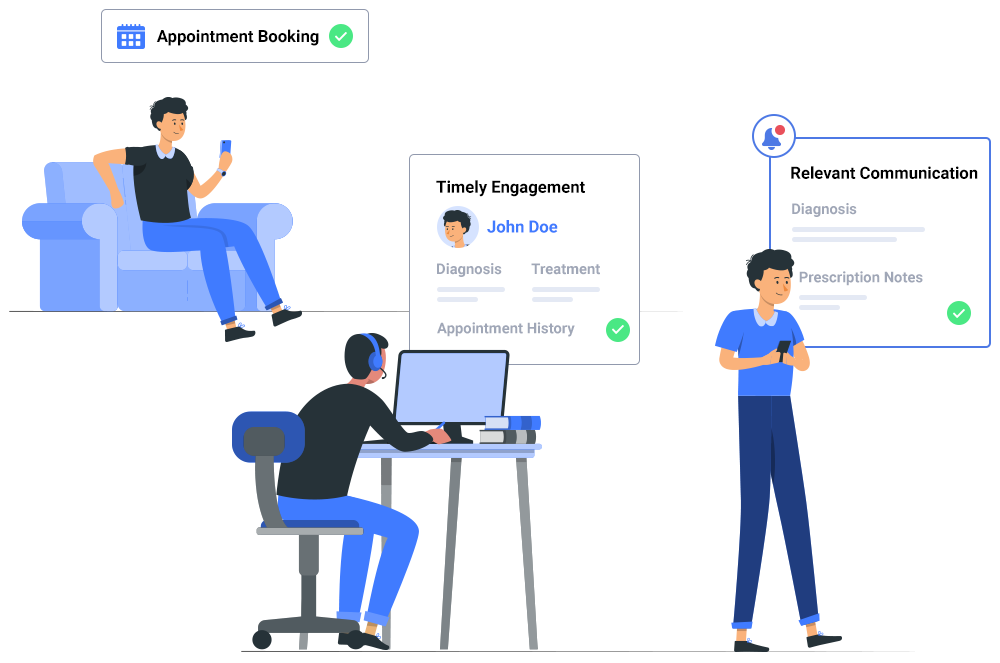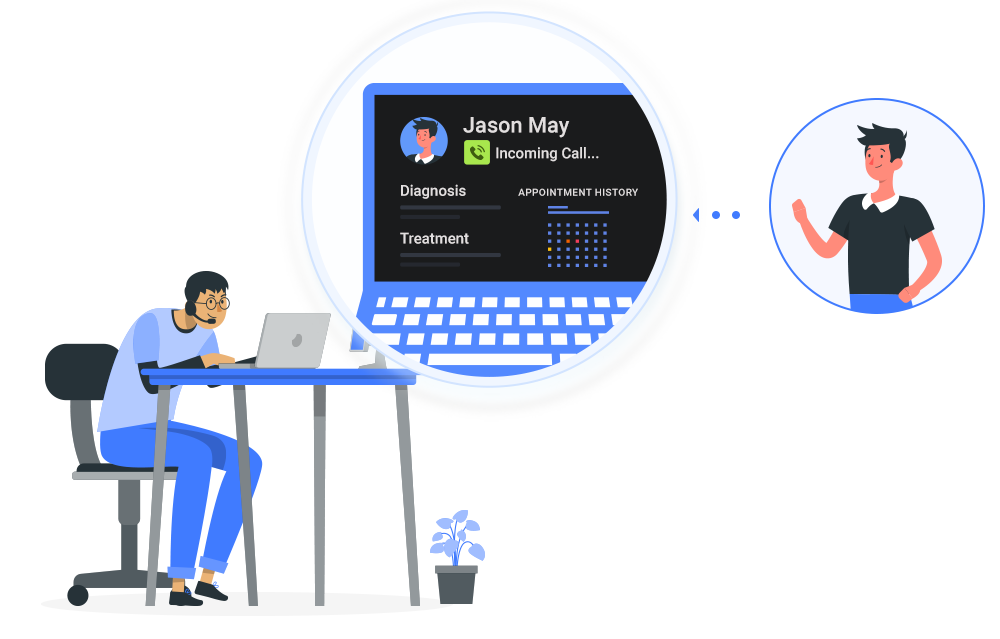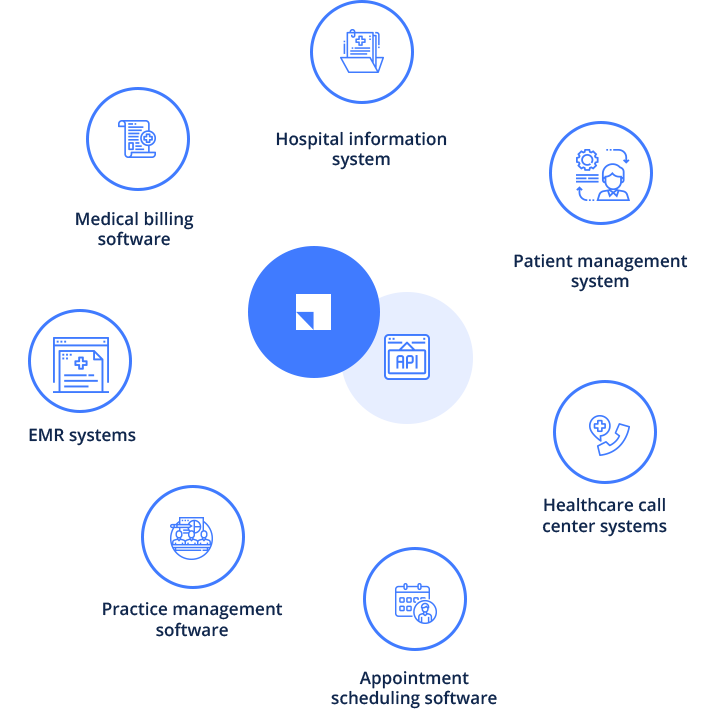- Home
- Learn
- Healthcare
- 14 Patient Retention Strategies To Grow Your Healthcare Practice
HEALTHCARE
14 Patient Retention Strategies To Grow Your Healthcare Practice
Contents

Keep patients coming back for your care by implementing these 14 trusted patient retention strategies. Grow your healthcare practice organically.

Imagine this, you’re a healthcare provider who has just opened a new practice. You’ve got a great team, a beautiful facility, and you’re ready to help your community.
But as the weeks and months go by, you notice that your patient numbers aren’t growing as quickly as you’d hoped. In fact, you’re losing patients at a faster rate than you’re acquiring them, making it crucial to focus on retaining each existing patient.
You’re not alone, and patient retention research shows that the average national patient growth rate is only 45% while the patient churn rate is a whopping 48%. That means healthcare providers aren’t able to build long term relationships with their patients. And to make matters worse, 67% of patients are likely to sever ties with a brand due to bad experiences.
In this blog post, we’ll discuss some effective patient retention strategies that you can implement to improve your relationship with patients and boost patient satisfaction.
So, let’s dive in!
Building trust with patients is a critical component of long-term engagement for healthcare practices. When healthcare providers establish trust with their patients, it creates a bond that can endure various changes, such as shifts in insurance coverage or changes in healthcare providers. This bond of trust ensures that patients continue to seek high-quality care and remain loyal to your healthcare institution.
Addressing patient attrition is essential to ensure that patients continue to seek high-quality care and remain loyal to your healthcare institution.
Additionally, retaining patients can increase patient referrals. Satisfied patients are more likely to recommend your practice to their friends and family, which can lead to an influx of new patients.
Furthermore, this can help you cut marketing costs as you will not have to spend money on acquiring new patients. It costs 90% less to retain a patient than to entice a new one!
Finally, retaining patients can lead to increased revenue for your practice. When patients return to your facility for follow-up appointments, or long-term treatments, it results in more billable services and ultimately, more revenue.
Now let’s look into a few patient retention strategies you can implement to build long-term relationships with your patients.
One key factor in retaining patients is having an effective communication and outreach program. In today’s fast-paced world, patients have many choices when it comes to healthcare providers. Setting clear patient expectations through timely and personalized communication is one crucial element for building their trust and dependability.
A communication and outreach program can help you stay connected with your patients and stand apart from your competitors. Following are a few activities to include in your communication program:

Moreover, patients’ overall experiences can be improved via a patient portal that allows them access to health information, appointment booking, and communication with the medical staff. By making it simple for them to get the information they need and communicate with your office, there is a chance that patients will schedule more visits.
Now, let’s not forget about the good old-fashioned phone call. Sure, patient portals and online chat options are great for tech-savvy patients who prefer that kind of communication, but they don’t work for everyone. Sometimes, you just need to talk to a real person to get the answers you need.
According to a research, 88% of patients like the concept of the call, and the ones receiving these calls find them beneficial. That’s why it’s essential to have a dedicated phone line for patients to call and speak with a member of your team. It’s vital to have a team member who is available and willing to take calls during business hours and implement an IVR for after-hours.
[Also Read: Guide to Improve Customer Service for Healthcare Businesses for a couple of tips and strategies that’ll transform your customer service.]

So far, we’ve discussed the importance of being available to patients through different modes. Another thing that’s crucial to patient retention is fostering strong patient relationships by providing assistance in every stage of the patient’s journey. Healthcare institutions need to understand their needs and concerns and address them proactively to become their partner in health, not just their provider.
You can start by keeping detailed patient records and tracking their progress. Integrating your EMR to your healthcare CRM will help you capture and manage patient records efficiently. It’ll also help you identify any potential issues and address them before they become more significant problems. Another way is by providing patients with educational resources and support groups which help patients understand their condition and feel more in control of their health.
Also, check in with patients and connect with them at each stage of the patient journey. Here are some examples of messages to share with patients before and after appointments:
Before the appointment:
After the appointment:
Always share the above-mentioned communication on the preferred mode by patients. It could be a text message, WhatsApp message, a call or even an email. Furthermore, a HIPAA-compliant Healthcare CRM enables you to integrate with such channels and automate the messages.
Anyone who’s ever been to a doctor’s consultation knows that waiting can be a drag. And let’s be honest, nobody likes sitting around for hours, especially when they’re not feeling well. So, it’s no surprise that long wait times and a bad waiting room experience can significantly impact patient satisfaction and retention. Research shows that 1 in 5 patients switch care providers because of longer wait times.
Digital intake processes and online patient portals are one of the best ways to reduce wait time. Platforms like LeadSquared provide self-serve patient portals to simplify the document collection process. Some providers also use virtual waiting rooms where patients can book appointments and complete the onboarding process from the comfort of their homes rather than waiting at the clinic.
Once you have reduced the waiting time, the next step is to improve the waiting room experience.
Below are a few ways you can do this:
Overall, providing a comfortable and welcoming environment will make patients feel more relaxed and less stressed, creating a positive experience that ensures recurrent visits and higher retention.
Personalized care plans are tailored to each patient’s needs and take their medical history, lifestyle, and preferences into account.
However, to build a personalized plan, detailed patient records and tracking of progress over time are essential. A healthcare CRM can help you keep track of patients’ medical records, activities, and history to personalize care plans.
Even though implementing personalized care plans can be a little more time-consuming and resource-intensive than a one-size-fits-all approach, it’s worth it in the long run.
By building an integrated system, healthcare providers can streamline processes, improve communication and coordination between departments, and ultimately provide a better patient experience.
The stepping stone is to have a centralized electronic health record (EHR) system that all departments can access. This allows them to share patient information easily and eliminates the need for paper records. You can also use technology to automate administrative tasks, such as appointment scheduling, billing, and follow-up calls. It saves time, reduces errors, and improves the overall experience.
[Also Read: 7 Healthcare Workflow Automation to Improve Patient Care to learn about the processes you can automate to transform patient experience]
Research shows, 60% people are more likely to trust and follow the recommendations of friends and family. Encouraging patients to refer their friends and family can be a powerful way to grow your practice and enhance patient loyalty while improving retention ratios.
Additionally, when someone refers a friend or family member to your practice, it’s a sign that they’re happy with the care they’ve received and want to share that experience with others. And when patients feel good about their experience, they’re more likely to stick around.
You can use technology to make it easy for patients to refer their friends and family. To encourage them, you can also incentivize referrals by offering rewards or discounts to patients who refer others to your practice.
It always feels nice when you get a little extra for what you paid.
Your patients can experience this “nice” feeling through subscription plans. You can create yearly or bi-yearly subscription plans that reward patients for committing to a specific care period with your practice.
Patients who feel like they’re getting something special for committing to a year of care with your practice are more likely to return. These plans also encourage patients to schedule appointments in advance, which can help you better plan your schedule and keep your practice running smoothly.
To create a yearly subscription plan, healthcare providers can use various tools, such as patient management software, to track patient visits and provide rewards accordingly.
Nobody likes dealing with complicated billing processes, and it’s no different for patients. In fact, it can be a major pain point for patients and even lead to them leaving your practice. That’s why making billing easy is crucial to improving patient retention.
Here are a few ways you can make billing and onboarding easy:

Your staff is the face of your healthcare facility and the first point of contact for patients. It’s important that they’re well-trained and can provide a friendly, welcoming environment for patients. This not only helps create a positive first impression, but it can also play a big role in increasing patient retention.
Here are a few ways to train your staff to be more patient-focused:
Training your staff to be friendly and patient-focused can assure your patients that they matter. Prioritizing their comfort and well-being can go a long way toward building trust and loyalty with them.
Educating patients is an underappreciated aspect of patient retention. When healthcare providers take the time to inform and educate their patients, they empower them to take an active role in managing their health. This empowerment can lead to increased patient engagement, satisfaction, and improved patient retention.
By providing patients with the knowledge and resources they need, healthcare providers can help them understand their conditions, treatment options, and the importance of adhering to prescribed care plans. This not only enhances patient engagement but also fosters a sense of trust and loyalty. Patients who feel informed and supported are more likely to follow through with their treatment plans and return for follow-up appointments.
Moreover, educational initiatives such as workshops, informational brochures, and online resources can be invaluable. These tools can help patients make informed decisions about their health, leading to better health outcomes and a higher level of patient satisfaction. In turn, satisfied patients are more likely to remain loyal to their healthcare providers, thereby improving patient retention rates.

Tracking patient retention rates is crucial for healthcare providers aiming to enhance their retention strategies. By closely monitoring these rates, providers can gain valuable insights into the effectiveness of their current practices and identify areas that need improvement.
Understanding patient retention rates allows healthcare providers to make data-driven decisions that can significantly increase patient retention. For instance, if a particular retention strategy is not yielding the desired results, providers can adjust their approach based on the data collected. This continuous monitoring and adjustment process ensures that retention strategies remain effective and relevant.
Additionally, tracking patient retention can help healthcare providers identify patterns and trends. For example, they might discover that certain demographics are more likely to leave the practice, prompting targeted interventions to address these specific groups’ needs. By staying informed and proactive, healthcare providers can implement more effective retention strategies, ultimately improve patient retention and better patient outcomes.
Health rewards programs are an innovative way to improve patient retention by incentivizing patients to engage in healthy behaviors and adhere to their treatment plans. These programs can motivate patients to take an active role in their care, leading to better health outcomes and increased patient satisfaction.
By offering rewards and incentives, healthcare providers can encourage patients to follow through with their prescribed care plans, attend regular check-ups, and make healthier lifestyle choices. For example, patients might earn points for attending appointments, participating in wellness programs, or achieving specific health goals. These points can then be redeemed for rewards such as discounts on services, health-related products, or even gift cards.
This can translate into better patient retention.

In today’s digital age, a strong online reputation is essential for healthcare enterprises looking to attract and retain patients.
This can be achieved by actively managing their online reviews, engaging with patients on social media, and providing valuable content through blogs and other online platforms. Responding to patient reviews, both positive and negative, shows that the provider values patient feedback and is committed to improving patient experiences.
Additionally, maintaining an informative and user-friendly website can enhance a provider’s online reputation. Patients often turn to the internet for information about healthcare providers, and a well-designed website can make a lasting impression.
By focusing on building a strong online reputation, healthcare practices can attract new patients and retain existing ones, leading to improved patient retention and better patient outcomes.
So, there you have it folks, the best strategies that can help you build long-term relationships with your patients. From effective communication and outreach programs to personalized care plans and reducing wait times, there are plenty of ways to keep your patients happy and coming back.
But remember, patient retention isn’t just about keeping the ones you have, it’s also about attracting new patients. Encourage referrals, create loyalty programs, and make billing and onboarding easy.

While it can be very overwhelming to manage all the activities manually, a healthcare CRM can help you automate most of the processes. To know more, you should get in touch with our team today.
Awantika is a healthcare marketer with LeadSquared. She has been a part of the content and product marketing game for almost 3 years. You can connect with her on LinkedIn or write to her at awantika.sama@leadsquared.com.
(+1) 732-385-3546 (US)
080-47359453 (India Sales)
080-46801265 (India Support)
62-87750-350-446 (ID)
(+971)-553-353-122 (UAE)

 Innovations in Telemedicine – How to adapt for the future?
Innovations in Telemedicine – How to adapt for the future?